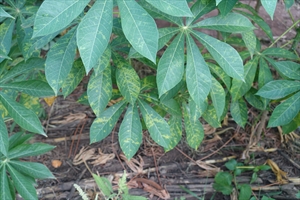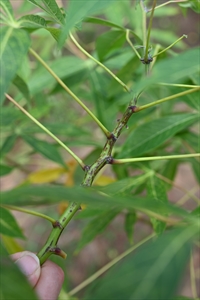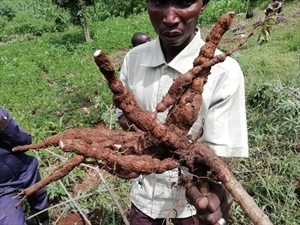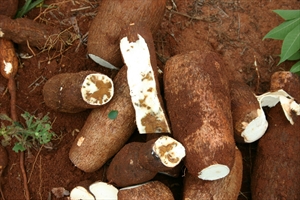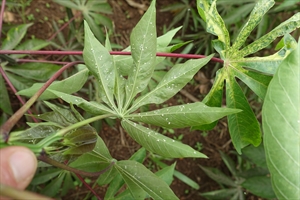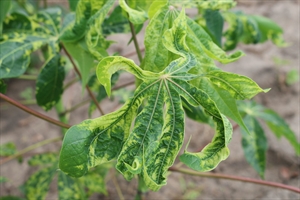Cassava brown streak disease
Pacific Pests, Pathogens and Weeds - Online edition
Pacific Pests, Pathogens & Weeds
Cassava brown streak disease (439)
Cassava brown streak virus and Ugandan cassava brown streak virus are the cause of the disease. The abbreviations of these viruses are CBSV and UCBSV), respectively. The virus particles are flexuous rods, about 650 nm. Severe and mild isolates exist.
Africa. The disease was once limited to lowland (<1000 masl) coastal East Africa, but since early this century epidemics have occurred in several East and Central African countries, and at higher altitudes. In West Africa, it is present only in Equatorial Guinea, and Kongo Central Province, Democratic Republic of the Conga. The disease is not recorded from Oceania.
Cassava, and wild cassava, Manihot glaziovii.
Plants with CBSD show symptoms on the older leaves (Photo 1), stems and in the roots. Yellow patches occur along the secondary veins, those branching from the midribs, and they often join together (Photos 2&3). Streaks may appear on the young green stems (hence the name of the disease) (Photo 4). Dieback occurs in the most susceptible varieties. Roots may be smaller than normal, show constrictions (Photo 5), and have dark brown dry rots in the flesh (Photos 6&7).
Disease symptoms vary according to variety and growing conditions. Sometimes, symptoms occur on the leaves, but the roots look healthy, and sometimes symptoms occur in the roots, but the leaves look healthy. Further, streaks on the stem that are considered a characteristic of the disease, do not always appear or are hard to see.
Spread is over short distances by whiteflies (Photo 8), Bemisia tobaci biotype B (Bemisia argentifolii) (see Fact Sheet no. 284). Whiteflies acquire the viruses in 5-10 minutes, remain infected for 48 hours, and spread the viruses less than 17 m in a cropping season. Longer spread is through exchanges of planting material between farmers.
The reason for the sudden increase in CBSD is not well understood, but it seems that the large increase in numbers of whiteflies above 1000 masl is an important factor.
Impact from CBSD depends on variety and location. It also depends on the how long the crops remains in the ground, a traditional method of storage. Unexpected losses at harvest for household use or sale can have devastating economic consequences on families.
CABI reports an economic study on small-scale farmers in Malawi where yield losses from CBSD ranged from 18-25%1. However, losses in yield of sensitive varieties can be total. Overall losses of US$750 million a year have been estimated across Kenya, Tanzania, Uganda, Malawi. The disease now threatens the food security in those countries as well as the cassava-growing areas of Central and West Africa.
Look for the yellow blotches along the veins from the midrib; these become patches as they join together. Look for occasional streaks on the stems, and dry brown root rots. Note that another virus disease, caused by Cassava mosaic virus (CMV), causes similar symptoms. However, CMV occurs on young expanding leaves, and causes leaf distortions (Photo 9).
In Nigeria, IITA has established the Cassava Disease Surveillance Platform, where extension staff can upload images of plants suspected of CBSD (and other cassava diseases). There are immunological and molecular tests for the viruses.
BIOSECURITY
Countries still free from the cassava brown streak disease should take all practical measures to prevent its introduction and further spread. Whenever cassava varieties are moved between countries they should be as pathogen-tested plantlets growing in sterile media according to the FAO/IBPGR Technical Guidelines for the Safe Movement of Cassava Germplasm - https://www.google.com.au/webhp?sourceid=chrome-instant&ion=1&espv=2&ie=UTF-8#q=international%20guidelines%20for%20cassava.
CULTURAL CONTROL
Before planting:
- Only take cuttings from plants that have been monitored during growth for the absence symptoms on the leaves or in the roots at harvest.
- Encourage all farmers in a community to rogue infected plants in their farms; this will reduce the speed of spread of CBSM substantially.
- Preferably, use certified planting material from schemes (e.g., Great Lakes Cassava Initiative) that have been cleaned of virus and multiplied in sites with low disease levels and whitefly populations.
During growth:
- Rogue plants showing signs of leaf and stem symptoms. If not removed, whiteflies will infect nearby plants. (Farmers need to be trained in identification of symptoms for this to be an effective method of sustaining low disease in their fields).
After harvest:
RESISTANT VARIETIES
Where the disease has long been present, farmers have made selections that show leaf symptoms, but have delayed root rot and acceptable yields. Many have been virus-cleaned, shared, evaluated and used in plant breeding programs to develop relatively low levels of root rot. Additionally, lines are also being bred that prevent virus multiplication. Enquire about tolerant and resistance varieties near you.
CHEMICAL CONTROL
Broad-spectrum insecticides such as pyrethroids (e.g., deltamethrin, lambda-cyhalothrin, bifenthrin), neonicotinoids (e.g., imidacloprid) and organophosphates (e.g., chlorpyriphos) should be avoided, as repeated use promotes the development of resistant populations of whiteflies, and will also destroy natural enemies. Resistance to insecticides is a particularly serious problem in the control of the silverleaf B and Q biotypes (see Fact Sheet no. 284), which have become resistant to a wide range of insecticides.
If insecticides are required, do the following:
- Use horticultural oil (made from petroleum), white oil (made from vegetable oils), or soap solution (see Fact Sheet no. 56). The sprays will not kill all of the whiteflies, but will allow predators and parasites to increase and bring the whitefly infestation under control. Frequent applications (every 3-5 days) and good coverage is required.
- Several soap or oil sprays will be needed to bring the whiteflies under control. It is essential that the underside of leaves and terminal buds are sprayed thoroughly since these are the areas where the whiteflies congregate. It is best to spray between 4 and 6 pm to minimise the chance of leaves becoming sunburnt.
- White oil:
- 3 tablespoons (1/3 cup) cooking oil in 4 litres water.
- ½ teaspoon detergent soap.
- Shake well and use.
- Soap:
-
Use soap (pure soap, not detergent).
- 5 tablespoons of soap in 4 litres water, OR
- 2 tablespoons of dish washing liquid in 4 litres water.
-
- White oil:
- Commercial horticultural oil can also be used. Note, these sprays work by blocking the breathing holes of insects causing suffocation and death.
____________________
When using a pesticide, always wear protective clothing and follow the instructions on the product label, such as dosage, timing of application, and pre-harvest interval. Recommendations will vary with the crop and system of cultivation. Expert advice on the most appropriate pesticides to use should always be sought from local agricultural authorities.
AUTHOR Grahame Jackson
Information from 1CABI (2020) Cassava brown streak viruses (cassava brown streak disease). Crop Protection Compendium. (https://www.cabi.org/cpc/datasheet/17107); and Tomlinson KR et al. (2018) Cassava brown streak disease: historical timeline, current knowledge and future prospects. Molecular Plant Pathology 19(5):1282-1294. (https://www.ncbi.nlm.nih.gov/pmc/articles/PMC5947582/); and Amisse JJG et al. (2019) First report of cassava brown streak viruses on wild plant species in Mozambique. Physiological and Molecular Plant Pathology 105:88-95. (https://doi.org/10.1016/j.pmpp.2018.10.005); and from Cassava brown streak disease: control measures, Uganda. National Crops Research Institute, Namulonge, Kampala, Uganda. Food and Agriculture Organization of the United Nations. (http://www.fao.org/3/CA2940EN/ca2940en.pdf). Photos 1-5,&7,8 Stephen Winter, Department of Virology, DSMZ-German Collection of Microorganisms and Cell Cultures, Braunschweig, Lower Saxony, Germany. Photo 6 Abigail Rumsey International Institute of Tropical Agriculture (Flickr). Ibadan, Nigeria. Photo 9 H. Holmes/RTB Cassava mosaic disease (CMD) symptoms in a field in Tanzania. Root, Tubers and Bananas. CGIAR.
Produced with support from the Australian Centre for International Agricultural Research under project HORT/2016/185: Responding to emerging pest and disease threats to horticulture in the Pacific islands, implemented by the University of Queensland and the Secretariat of the Pacific.

